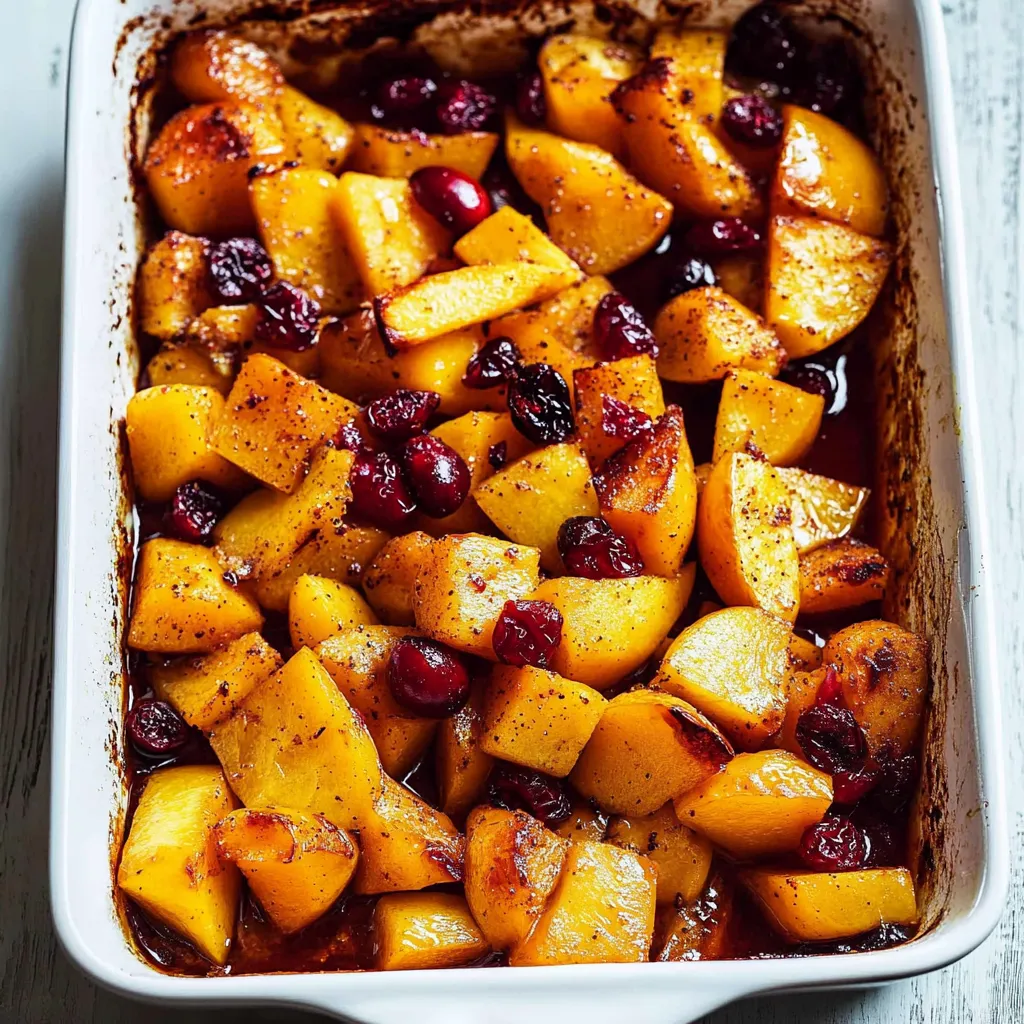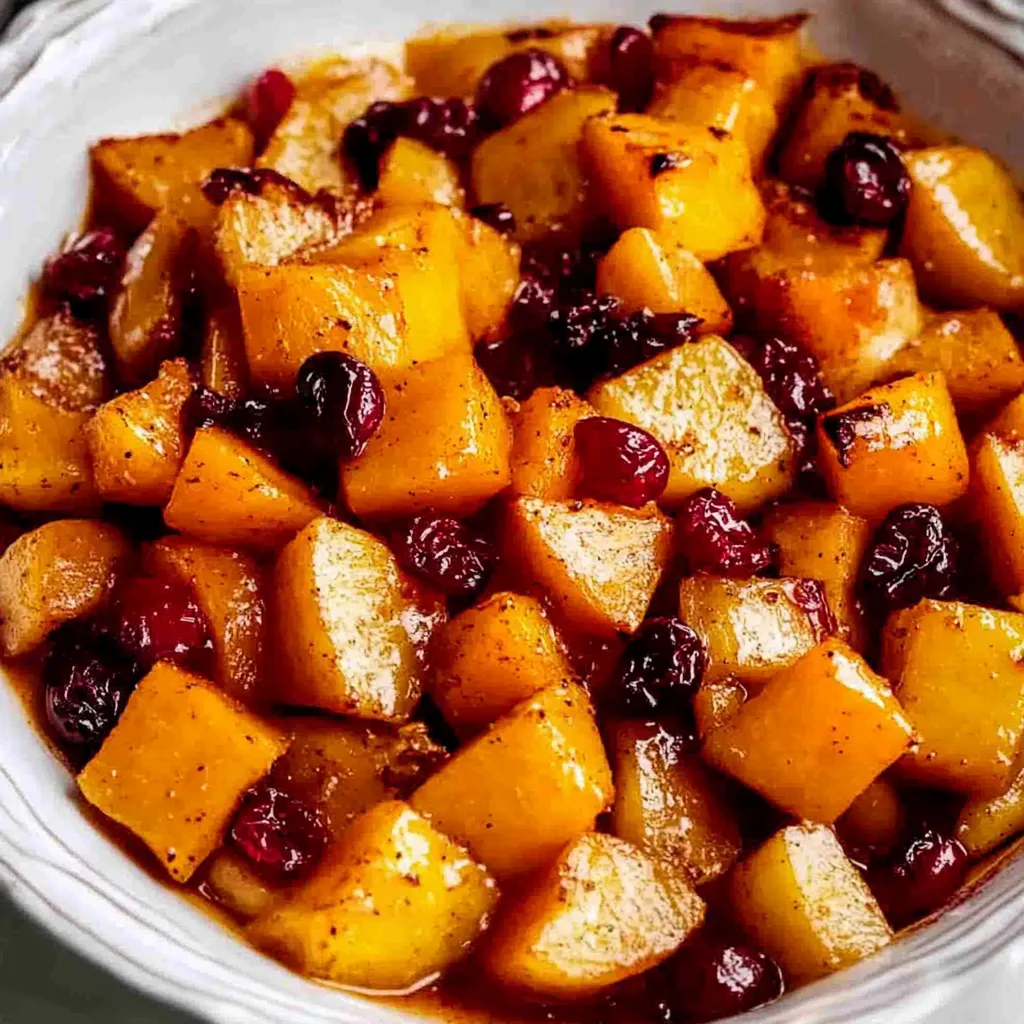 Pin it
Pin it
Roasting butternut squash with apples and cranberries creates a side dish that balances sweet, tart, and savory flavors perfectly for fall meals. The squash and apples caramelize as they bake, developing natural sweetness that pairs beautifully with tart cranberries bursting throughout. A simple maple-cinnamon glaze coats everything and thickens into something almost caramel-like as the casserole cools. This works equally well for weeknight dinners or holiday spreads, and the best part is making it ahead so you're not scrambling on the day you need it.
Butternut squash casseroles became my go-to holiday side after realizing they satisfy everyone - vegetarians, gluten-free guests, and traditional eaters all happily eat this without complaint. The original version I tried was loaded with brown sugar and butter, but swapping to maple syrup and coconut oil made it healthier without sacrificing flavor. Adding cranberries was a revelation because their tartness cuts through all that sweetness and prevents the dish from becoming cloying. Now I make this for Thanksgiving every year and people specifically request it, which feels good when you've created something both delicious and nutritious.
Ingredients and Why They Matter
- Butternut squash: (1 large, about 3 pounds) - Naturally sweet when roasted with buttery texture; acorn squash or sweet potatoes substitute
- Apples: (2 large, thinly sliced) - Add sweetness and texture; use Gala, Honeycrisp, or McIntosh that hold up when baked
- Fresh or frozen cranberries: (1 cup) - Provide tartness that balances sweetness; dried cranberries work but are sweeter
- Pure maple syrup: (⅓ cup) - Natural sweetener that creates glaze; honey or coconut sugar substitute
- Coconut oil: (¼ cup, melted) - Forms glaze base; use refined for no coconut flavor, or substitute butter
- Tapioca starch: (1 tablespoon) - Thickens the glaze; cornstarch or regular flour works
- Ground cinnamon: (1½ teaspoons) - Warm spice essential to fall flavors
- Ground nutmeg: (¼ teaspoon) - Adds depth without overwhelming
- Sea salt: (½ teaspoon) - Brings out sweetness and balances flavors
How To Make It
- Prep the squash and apples:
- Preheat your oven to 350°F. Use a large, sharp chef's knife to carefully cut both ends off the butternut squash so it sits flat. Stand the squash upright on one cut end and carefully slice it in half lengthwise down the middle. Use a spoon to scoop out all the seeds and stringy bits from the cavity. Use a vegetable peeler to remove all the tough skin from both halves - work slowly and carefully because squash can be slippery. Once peeled, lay each half flat-side down and cut into strips about 1 inch wide, then cut across to create 1-inch cubes. You want uniform pieces so everything cooks evenly. Peel the apples using a vegetable peeler, cut them in half, remove the cores, and slice thinly - about ¼ inch thick.
- Combine everything:
- Place the cubed butternut squash, sliced apples, and cranberries in a large mixing bowl. In a small bowl, whisk together the melted coconut oil, maple syrup, tapioca starch, cinnamon, nutmeg, and salt until smooth with no lumps of starch remaining. Pour this maple glaze over the squash mixture. Use your hands or a large spoon to toss everything together, making sure every piece of squash and apple gets coated with the glaze. The mixture will look wet and glossy.
- Initial bake covered:
- Transfer the coated squash mixture to an ungreased 7x11 inch baking dish or similar-sized casserole dish, spreading it out in an even layer. Cover the dish tightly with aluminum foil - this is important because the foil traps steam that helps everything cook through without drying out. Place in the preheated oven and bake for 35 minutes. The squash should be starting to soften but won't be fully tender yet.
- Toss and finish baking:
- Carefully remove the casserole from the oven and remove the foil. Use a large spoon to toss and stir everything, ensuring the pieces that were on top move to the bottom and vice versa for even cooking. Some liquid will have accumulated at the bottom - this is perfect and will become the glaze. Place the uncovered casserole back in the oven and bake for another 30-35 minutes until the squash and apples are very tender when pierced with a fork and everything looks slightly caramelized around the edges. The cranberries will have burst and released their juices.
- Rest and serve:
- Remove the casserole from the oven. You'll notice quite a bit of liquid at the bottom of the dish - don't worry, this is normal. Gently toss the squash, apples, and cranberries to coat everything in this liquid. Let the casserole sit at room temperature for 15-20 minutes without touching it. During this resting time, the liquid will thicken and caramelize slightly, coating everything in a beautiful glaze. Serve warm, spooning some of that thickened glaze over each portion. The casserole tastes even better the next day after the flavors have melded.
 Pin it
Pin it
Butternut squash intimidated me before learning the proper cutting technique. The key is creating flat, stable surfaces at each step so the squash doesn't roll around while you're wielding a sharp knife. Cutting off both ends first creates stability. Standing it upright to halve lengthwise works better than trying to cut it while it's lying down. Peeling after cutting is easier than trying to peel the whole round squash. Now I can break down a butternut squash in maybe five minutes without fear of losing a finger.
Squash Selection and Storage
Choose butternut squash that feels heavy for its size, which indicates dense, moist flesh inside. The skin should be hard, matte, and tan-colored without soft spots, bruises, or cuts. A bit of stem remaining is fine. Avoid squash with shiny skin which indicates under-ripeness. Store whole squash in a cool, dry place for up to 3 months - they actually get sweeter with some storage. Once cut, wrap tightly and refrigerate for up to 5 days. The convenience of pre-cut squash from stores saves time but costs more and won't be as fresh.
Apple Variety Matters
Not all apples work equally well in baked dishes. Firm, sweet varieties like Gala, Honeycrisp, or McIntosh hold their shape and provide pleasant sweetness. Avoid Granny Smith apples here because their tartness combined with tart cranberries creates too much acidity. Red Delicious turns mushy and flavorless when baked. Fuji apples work beautifully. Golden Delicious stay firm and sweet. Using a mix of varieties creates more complex flavor. Peel them because the skins can become tough and chewy during the long baking time.
Fresh vs Dried Cranberries
Fresh cranberries burst during baking, releasing tart juice that flavors the entire casserole and creates beautiful pink streaks. Dried cranberries stay intact and chewy, providing concentrated sweetness rather than tartness. Fresh cranberries are seasonal but freeze perfectly - buy extra bags in fall and freeze for year-round use. If using dried cranberries, reduce the maple syrup slightly because dried fruit is much sweeter. Some people use half fresh and half dried for varied texture and balanced sweet-tart flavor.
The Glaze Development
The maple-coconut oil mixture starts as thin liquid but thickens dramatically through two processes. First, the tapioca starch activates when heated, binding with liquid to create thickness. Second, as the casserole bakes uncovered during the second phase, moisture evaporates and concentrates the remaining liquid. The natural sugars from the maple syrup, squash, and apples caramelize, creating rich, complex sweetness. The resting period after baking allows everything to continue thickening and developing deeper flavor. What starts soupy becomes glossy, caramel-like glaze.
Make-Ahead Strategy
This casserole's make-ahead flexibility makes it ideal for holiday entertaining. Prepare completely up to 4 days ahead, refrigerate covered, and reheat in a 350°F oven for 15-20 minutes. Or prep the raw squash and apple mixture, refrigerate overnight, and bake the next day - just add 5-10 minutes to the cooking time since everything starts cold. For even longer storage, freeze the fully cooked casserole up to 1 month. Thaw overnight in the refrigerator before reheating. The glaze thickens considerably when cold but loosens beautifully when warmed.
Dietary Flexibility
The recipe naturally accommodates multiple dietary needs without modification. It's vegan using coconut oil, or use butter for vegetarian. It's gluten-free using tapioca starch. It's paleo and refined sugar-free with maple syrup. This versatility means serving one dish that everyone at the table can eat regardless of restrictions. Label it clearly at potlucks so guests with dietary needs know it's safe for them. The fact that it tastes delicious rather than like "diet food" means everyone chooses it happily.
Variations and Additions
The base recipe welcomes creative customization. Add chopped pecans or walnuts for crunch and richness. Sprinkle crispy bacon bits over the top for smoky, savory contrast. Use sweet potatoes instead of butternut squash for different sweetness. Add diced pears along with apples for more fruit variety. Stir in a splash of orange juice or zest for citrus brightness. Top with a streusel topping made from oats, nuts, and coconut oil for textural contrast. Each variation creates different flavor profiles while maintaining the basic technique.
 Pin it
Pin it
This butternut squash apple casserole represents the kind of holiday cooking that satisfies traditionalists while accommodating modern dietary preferences. The natural sweetness from roasted vegetables and fruit means you're not loading up on refined sugar, yet it tastes indulgent enough for special occasions. When you serve this with its beautiful fall colors and caramelized glaze, people think you've spent hours when really most of the time was just oven time. Sometimes the best recipes are the ones that make healthy eating feel celebratory rather than restrictive, and this casserole definitely accomplishes that goal perfectly every single time you make it.
Frequently Asked Questions
- → Can I make this casserole ahead of time?
- Yes, you can prep everything and mix it together, then store it covered in the fridge for up to 24 hours before baking. Just add a few extra minutes to the cooking time since it'll be cold.
- → What can I use instead of coconut oil?
- Butter or ghee work great if you're not keeping it vegan. You could also try avocado oil or any neutral cooking oil you have on hand.
- → How do I store leftovers?
- Keep any leftovers in an airtight container in the fridge for up to 4 days. Reheat in the oven or microwave until warmed through.
- → Can I freeze this casserole?
- Yes, this freezes well for up to 3 months. Let it cool completely, then store in a freezer-safe container. Thaw overnight in the fridge before reheating.
- → Do I have to peel the apples and squash?
- Peeling the squash is recommended since the skin can be tough. For apples, you can leave the peel on if you prefer, but peeling them gives a softer texture.
- → What type of apples work best?
- Firm apples like Granny Smith, Honeycrisp, or Fuji hold up well during baking and won't turn to mush. Pick whatever you enjoy eating.
